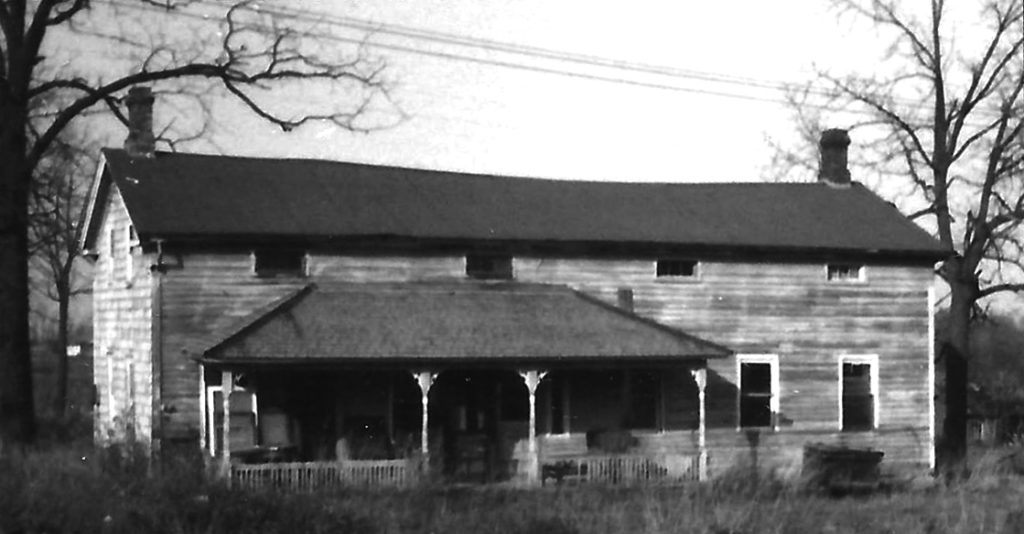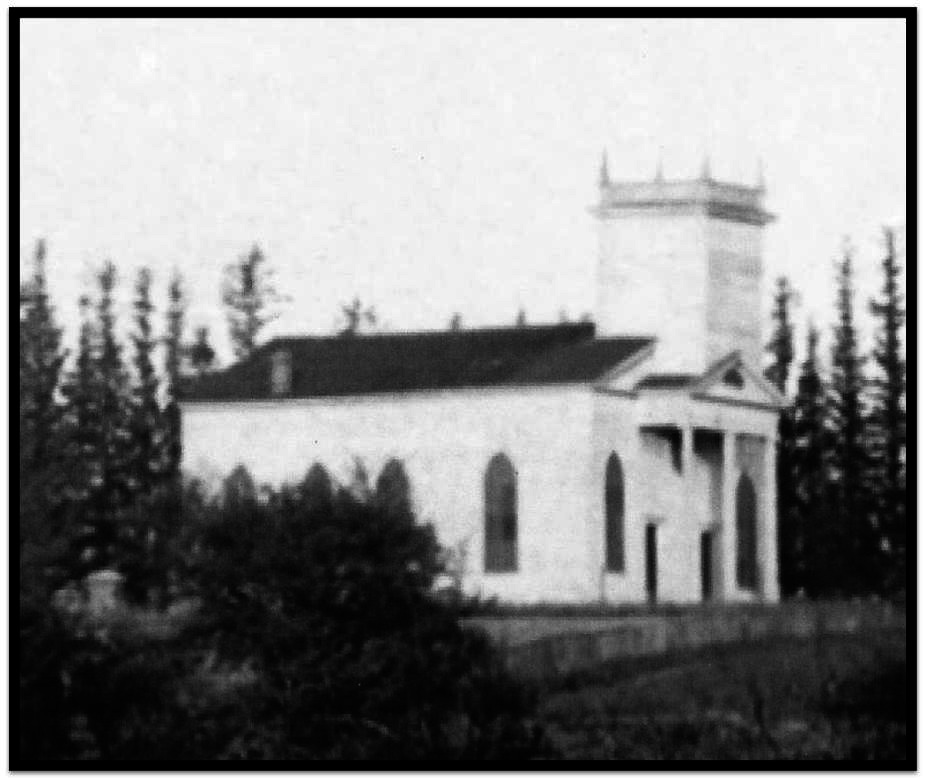Richmond History: Allens Hill: The Village Square
by Joy Lewis –
Part Two of the Early History of Allens Hill

The Allens Hill Episcopal Cemetery is the only remnant of the village square still surviving today. Though all the old buildings are gone, the cemetery gives us a stable reference point for visualizing the village as it would have been in the early years of the nineteenth century – the tavern on the west side, flanked by the shoemaker’s shop and opposed by the church and rectory, with the cooperage on the east side. The village green was a favorite playground of the young ones.
In reconstructing the village in “the mind’s eye” it is well to begin with the tavern. William Henry Shelton, born in Allens Hill in 1840, wrote much about his hometown: “After the church and store, the tavern was the next important village center. It was the stage-house where the four horse Concord stages stopped to change horses and throw off the leather mailbag and where the passengers alighted for refreshment, and behind it [were] the stage-barn with its stables.”
Gideon Gates built the tavern in 1808 on the spot where a tavern was to serve for nearly three-quarters of a century. This was on the north side of Belcher Road, close to the road well to the front of the main part of the cemetery. Gates’ Tavern was a three-story wooden structure in the style common to New England colonial inns of the period. The third floor was leased for a decade by the local Masonic Lodge.
In the fall of 1818 David Pierpont paid a thousand dollars for the tavern. Though he was to own it for several decades it continued to be known far and wide as the Gates’ Tavern. The original building burned in 1831 and a new tavern was needed. About a mile south of the village was the partially built home of Peter Allen, abandoned when he left for Indiana in 1816. Mr. Pierpont bought the place then contrived to move it to the top of the hill. One observer wrote that the building was “placed on [log] rollers, and drawn up by a long train of oxen; farmers coming from all parts of the country round with their teams to render what assistance they could. This was quite an event.”
Not only did the traveling public use the tavern, but the locals g
athered there as well. When the men of Allens Hill got together, there was sure to be talk of politics. A diary entry of March 12, 1829, written by the Episcopal minister is enlightening: “We have got somewhat accustomed to praying for our new President. If General Jackson is fortunate in having such multitudes of devoted admirers, he is unfortunate in being an object of dislike and distrust to so many.”
William Shelton wrote that “the voters in our village were Whigs and free-soil democrats [and] they were all opposed to slavery.” He had much to say about the topical discussions bandied about in the evenings by the locals, but he also noted that “about the barroom fire in the winter was another group of worthies who talked more about crops and the neighbors and old times than about politics.”
Temperance was a popular point of discussion, even from early days. Before Richmond voted to “go dry” in the 1840s there were six or seven distilleries in town. The tavern served liquor to travelers and to the locals as well. One observer noted with dismay, “this dram-drinking is a bad business. Several of our neighbors pass the door every morning and evening on their way to the tavern for their daily portion of bitters.”
Samuel Chipman, son of an early Richmond settler, was a noted Temperance Man. Editor of The Star of Temperance newspaper in Rochester (1828-1834), he was a prolific speaker and advocate of temperance. It was to his dismay, and to that of many another citizen, to see lounging about the streets of Allens Hill “the wreck of one who might have been a most valuable citizen, but who was of no use to himself or to anybody else. He went by the name of ‘Old Tompy,’ and was quite a character in his way. His large and powerful frame and active mind had now become much enfeebled by long habits of intemperance, and he generally made his appearance arrayed in rags, and as untidy as possible. He gave himself up almost entirely to hard drink, and he seldom made an appearance in public without being followed by a crowd of boys, who [teased and tormented him].”
John Quick ran the tavern after 1850. Shelton provides a vivid picture of the place at that time: “The barroom was the entrance hall where the guests were received before an open fire in the winter with a ste
aming kettle on the hob for toddies and Tom-and-Jerrys [eggnog with brandy, served hot]. There was the bar in the corner, with smiling John Quick behind it, against a background of sparkling glass with the register before him and a steel-pen in his hand…On the other front corner of the tavern was a reception room for the ladies. Such a room was needed in those days for the ladies did not drink or smoke.”
It was David Pierpont who, in 1818, established the stage route from Canandaigua to Geneseo which stopped at the Allens Hill Tavern. Traveling on alternate days from one town or the other, the stage sometimes arrived about eight o’clock in the morning and sometimes later in the day. “When the stage came into Allens Hill [at noon] it came with a clatter of galloping horses and pounding hooves. Its round body swung on leather straps, its gallant driver, its four smoking horses, and its merry horn were followed by shouting boys.”
The next quarter-century saw the gradual decline of the stage line. By the 1860s “a railway station was located five miles away and the Concord stages with the galloping horses and merry horn were taken off the road and succeeded by a one-horse trap. The business of the tavern dwindled for want of guests, and the landlord dozed on the porch from year to year until…[the business] went into bankruptcy.”
For a little space of time the old tavern sat empty, then about 1870 it was moved once again, this time coming home to its final resting place – on the northeast corner of Allens Hill Road and Bell Road, where it was used for many years as a blacksmith shop. (Though it was still often referred to by local residents as “the tavern.”)

Saint Paul’s Episcopal Church anchored the northern corner of the village square, situated off the main road behind the tavern and in front of the cemetery. Beside it to the east was the little “story-and-a-half” home of the minister and his family. The first full time minister was Alanson W. Welton, who took up his duties in 1815.
Before his arrival the congregation was served by traveling preachers who came once a month. Organized formally in April of 1813, the church members had begun meeting in one another’s homes five years earlier. In 1814 the church was erected (it was large enough to “accommodate about three hundred”) and the next January Rev. Welton took up his duties. Two services were held each Sunday – one in the morning and another in the afternoon. During the noon break the children attended Sunday School.
Rev. Welton remained with his country congregation for six and a half years. In the fall of 1821 he answered the call to go as a missionary to Michigan. His family endured a tortuous trip crossing Lake Erie: they were twice shipwrecked before reaching their destination. Once arrived, however, Rev. Welton set about the business of shepherding his flock. A plaque in St. Paul’s Episcopal Church in Detroit honors Rev. Welton with being the first Protestant minister in Michigan.
The next Episcopal minister at Allens Hill was Rev. George Norton; he came in 1823 and stayed for twenty years. Of his $300 annual salary, half came from the Episcopal hierarchy, and half from the local congregation. This was not commonly forthcoming in cash, however. A Donation Party for the minister and his family was held each year in December, “which was a great event…The farmers gave of their abundance. All day the sleds came loaded with wood and the young men helped to saw and split it up into lengths for the stove and fireplace. They filled the barn with hay for the horse and cow, and oats for the horse and corn for the pig. They filled the potato bin and his pork-barrel and brought him smoked hams and sausages and lard and candles and souse and headcheese and apple butter.”
By the early years of the twentieth century the village green was no more. The old tavern had been removed long since; the church was decommissioned and was soon to be demolished. Gone were the rectory and the out-dated cooperage. All that remains today are the sheltering pines and the cemetery.